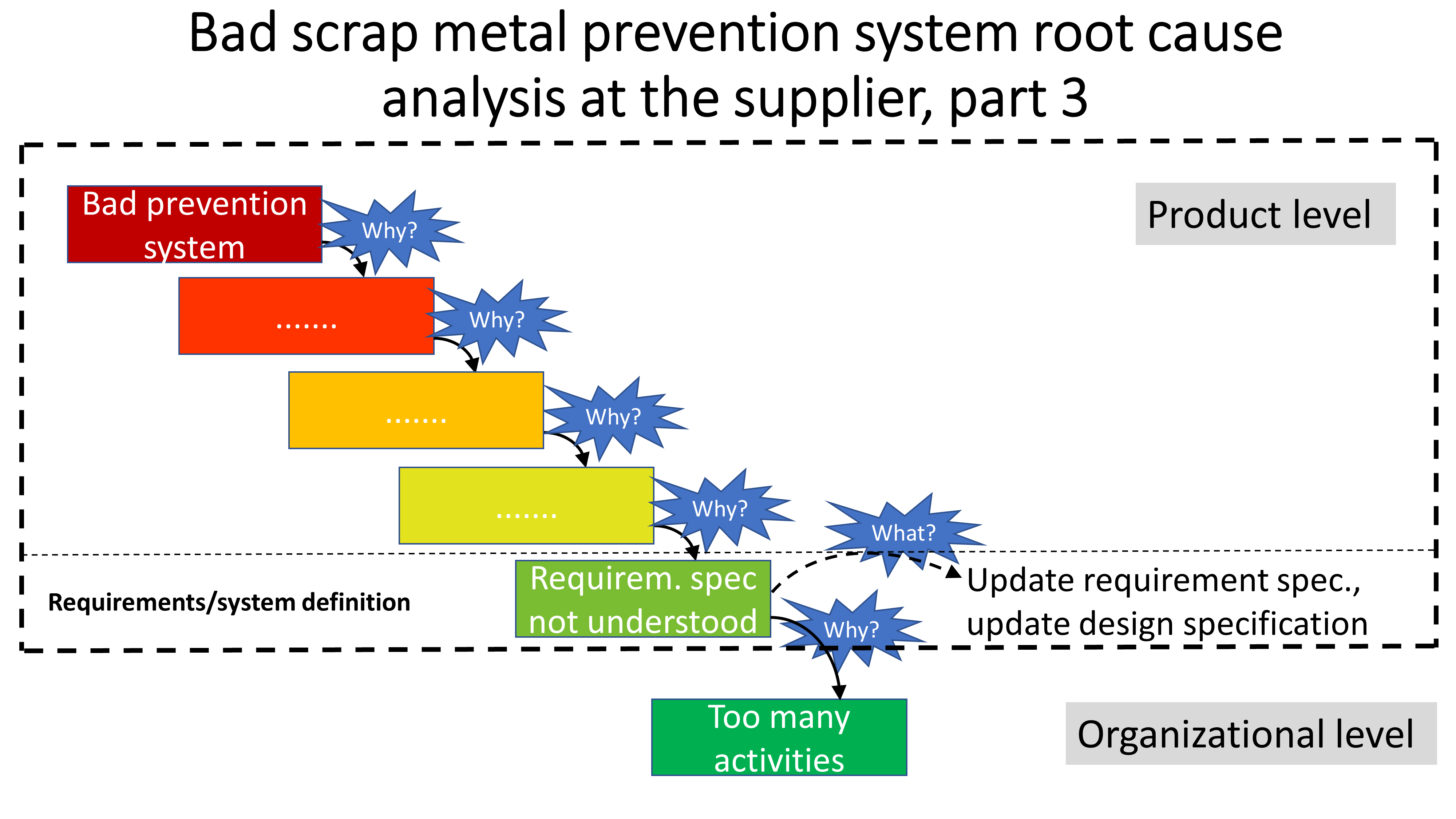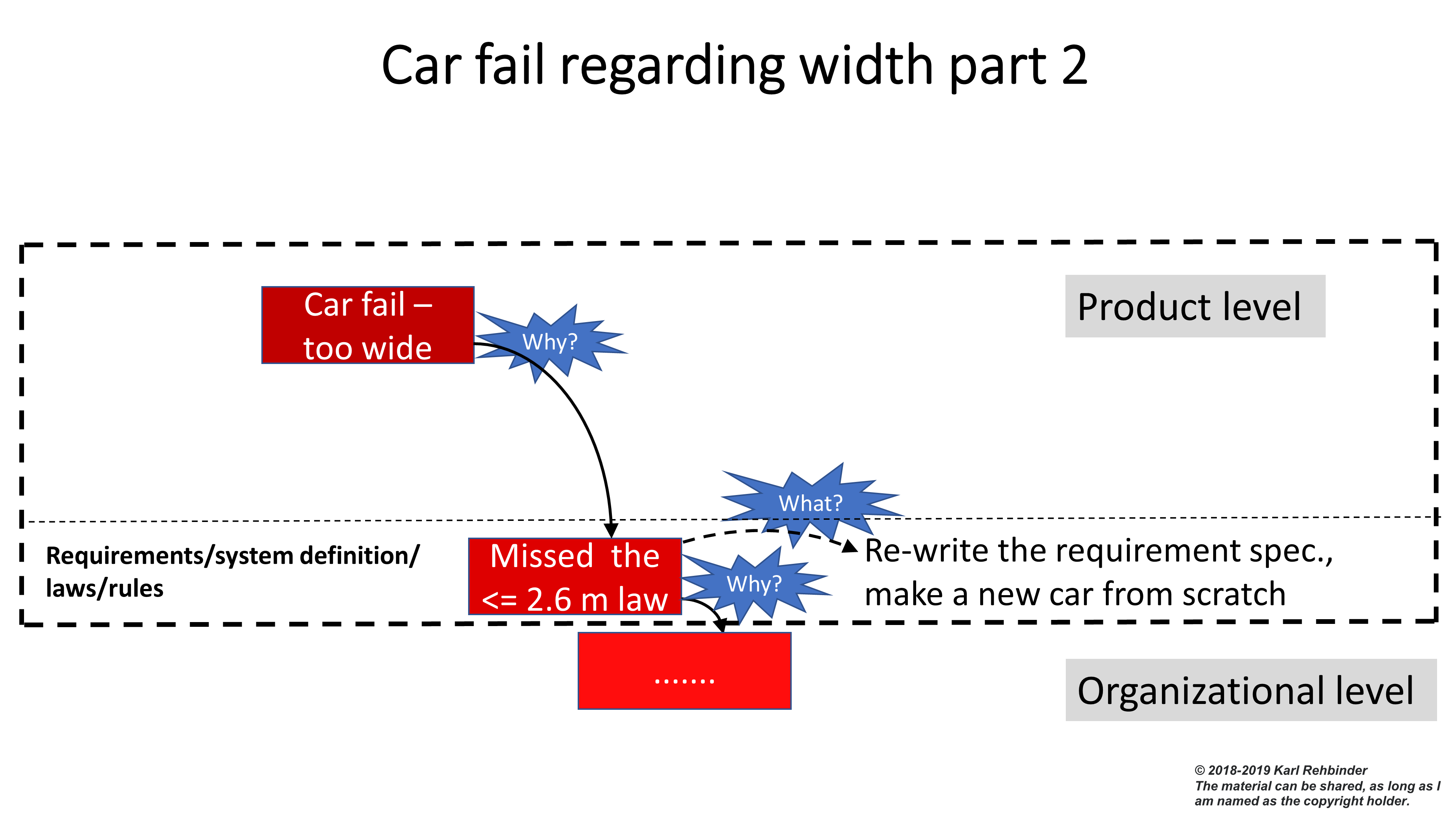In today’s blog post we are going to elaborate on where we will find the root causes to our organisational problems. We will also state what the Root Causes to organisational problems are, since we so far have not talked about the root causes specifically, only generally about the way of thinking to find them, no matter product or organisation level.
We start by going back to our example with the scrap metal prevention system, where we had this scenario:

All the other examples from the supplier showed the same thing, that all root causes regarding the different products, circulated around the requirements of the products in one way or another. And that is frankly what a root cause for a problem in a product is, it is a violation of the requirements; missing requirements, requirements not followed, faulty test cases, etc. for the product, or products testing the product, etc. An updated picture over the scenario for the scrap metal prevention system, with an added boarder for the requirements of the product, then looks like this:

If we also go back to our example with the car company that failed the car width it looks like this, when adding also the system definition boarder for their car:

And system requirements or system definitions or rules or laws, do not matter, they need to be followed for any product, and if not followed, we have non-fulfilled requirements in one way or another as root causes.
Note! When we know what product, we want to make, it is of course natural that within our requirement specification, we always need to follow the laws of science for our products, and these laws are seldom stated, but can never be ignored, since this will inevitable result in a failure of the product.
If we think deeper about system requirements for products, continuing with our car example, we have the regulations from the traffic authorities as laws that need to be followed for any car manufacturer. And together with the laws of natural science, these are frankly the only rules that needs to be followed to be able to drive the car on the road, the rest is internal requirements set by the car manufacturer itself, consequently giving infinite solutions when making cars. This is easy to see on the roads with many different models, and if we take the cars apart, they will be even more different on the inside.
If we go back to our supplier and look at all the analyses done to find the root cause and continue to ask why on the organisational level, we will finally also find the root causes for their organisational problems. If we put it together the scenario will look like this:

And if the same thinking goes for organisational problems, meaning that the root causes must be a violation of our total organisation definition, then we will have this scenario for any organisational problem (but, where we of course can have multiple chain of symptoms leading to many different root causes):

Now we have the following very interesting question that we need to get an answer to:
– Are these root causes unique for every organisation, or are the root causes actually the same for any organisation, in any domain and the different contexts within the domain?
But we already know that a root cause is a negated (non-fulfilled) requirement, rule, law, so let us make a twist and rephrase our question.
Instead, the thrilling question for us that we need an answer to now is:
– What about our organisations, our complex systems, do they also have laws or principles that they need to follow to get awesome in all aspects? Because, if there are laws, then we will also know the root causes, since they are the non-fulfilled (negated) laws, meaning our problem-solving will be very easy, with the same root causes valid for any organisational problem.
If you have been following this blog book since the start, you already know the answer:
YES!
From the history of organisations and market change series and the human science series and many more series of blog posts presented in the blog book introduction, we have already derived principles for how our organisations need to work to become awesome in today’s market. This is how our organisations must work in order to not violate our own evolutionary prerequisites, and the principles are concluded in this blog post.
And if we negate all the principles, not fulfilling any of them, we have all root causes that any organisational problem-solving can end up in, isn’t that easy, neat and tidy.
This also means that all organisational problems simply will have the same root cause(s), which also means that it is possible to make a Prefilled Problem Picture Analysis Map, where symptoms of common organisational problems can be found. This map makes it even more easy for any organisation with organisational problems to find the principles they are violating, the root causes to their organisational problems. An elaboration on the most common organisational problems with different chain of symptoms can be found in this series, and the completed Prefilled Problem Picture Analysis Map can be found in this blog post.
If we go back to our supplier and add the requirements/rules/laws/principles boarder, the scenario looks like this:

This is also good news since it leads to that no organisation need to invent their own principles, or to be correct, cannot or should not invent their own principles, to not risk violating our principles derived from human science. Because, the principles are within our DNA, and must therefore be followed. The principles must be seen as prerequisites developed by nature since ancient times through co-evolution for our needed ability to solve problems. The principles are already sealed, sent and delivered, with scaling possibilities and of course limitations and everything else for building organisations, complex systems, with us humans and our activities as the agents within the organisation. This means, that the more of these principles or laws an organisation follows, the higher the chance is for awesomeness, i.e., but remember that a few of them must be fulfilled, otherwise a way of working can fully malfunctioning.
In a sense this thinking about laws by nature are very similar for our products, because if we look at the laws of natural science, any product in the world need to follow these laws, no matter which product it is. The same goes for our organisations, the laws of human science need to be followed, no matter what the organisation is aimed for doing. For most of us, the latter requires a complete change of our patterns of thought, from reductionism to taking care of the whole. I really mean reductionism, since not fulfilling one or more principles means a complex mess of symptoms that we cannot explain. And if we try it means that we are trying to explain the impossible, which can then only be a simplistic solution, which means reductionism. But, when we are dealing with the whole, it means that we are dissolving the problems and the root causes, from the concept dissolve a problem, that Dr. Russell Ackoff stated.
So, when we know what our organisation is going to do, domain and different contexts, how many people we are, production or service or product development, different places in the world, etc., we can set up our organisation.
BUT, we need to do it by following our set of principles. And here we have the extremely big difference to any product, since any organisation in the world, are put together with the same parts (us) to a complex system, which is very different from our products, where we form the parts ourselves to complicated systems. And only in the latter case we can use the engineering metaphor with reduction and aggregation, which Dave Snowden clearly brings up in this easy-to-read-blog-post. But, regarding the organisational system, we need to dissolve the root causes, which indirectly means that we do not need to do Dispositional state mapping or any other mapping of the organisation’s current state. Dispositional state should only be used, when we do not have the possibility or/and mandate to dissolve the root causes ourselves.
So, when a company is successful; with great innovations, flow and resource efficiency, flexible and fast to the market with the right product and having healthy and respected people, we can state, since the way of working is fulfilling all the human science, that the company is:
Awesome by nature.
That was all for this blog post and if your patterns of thought have not been changed yet, watch out for tomorrow’s summary blog post and all the implications that follows from what we have found so far.
C u then.

